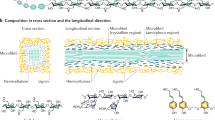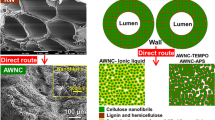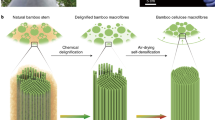Abstract
Wood is a renewable and eco-friendly resource with great promise to advance sustainability in various industries, particularly those associated with construction and building materials. To maximize wood uses, here we show a processing route that transforms low-value wood (residual, damaged, decayed, disposed or fractured) into lightweight and strong structural materials. The process involves delignification, combined with partial dissolution and regeneration, to expose cellulose fibrils originally present in the cell walls. The latter form strong hydrogen bonding networks at interphases, leading to a ‘healed’ wood with a mechanical strength that exceeds that of typical metals and commercial laminated wood. Moreover, recyclability as well as excellent resistance against organic solvents are demonstrated, providing a promising valorization and sustainability pathway for low-value wood.
This is a preview of subscription content, access via your institution
Access options
Access Nature and 54 other Nature Portfolio journals
Get Nature+, our best-value online-access subscription
$29.99 / 30 days
cancel any time
Subscribe to this journal
Receive 12 digital issues and online access to articles
$119.00 per year
only $9.92 per issue
Buy this article
- Purchase on Springer Link
- Instant access to full article PDF
Prices may be subject to local taxes which are calculated during checkout





Similar content being viewed by others
Data availability
Data are available on reasonable request from the authors, according to their contributions.
References
Launey, M. E. & Ritchie, R. O. On the fracture toughness of advanced materials. Adv. Mater. 21, 2103–2110 (2009).
Wegst, U. G., Bai, H., Saiz, E., Tomsia, A. P. & Ritchie, R. O. Bioinspired structural materials. Nat. Mater. 14, 23–36 (2015).
Wang, J., Li, Y., Hu, G. & Yang, M. Lightweight research in engineering: a review. Appl. Sci. 9, 5322 (2019).
Ritchie, R. O. The conflicts between strength and toughness. Nat. Mater. 10, 817–822 (2011).
Zhang, X., Chen, Y. & Hu, J. Recent advances in the development of aerospace materials. Prog. Aeronaut. Sci. 97, 22–34 (2018).
Kim, S. H., Kim, H. & Kim, N. J. Brittle intermetallic compound makes ultrastrong low-density steel with large ductility. Nature 518, 77–79 (2015).
Gludovatz, B. et al. A fracture-resistant high-entropy alloy for cryogenic applications. Science 345, 1153–1158 (2014).
Munch, E. et al. Tough, bio-inspired hybrid materials. Science 322, 1516–1520 (2008).
Zhu, H. et al. Wood-derived materials for green electronics, biological devices, and energy applications. Chem. Rev. 116, 9305–9374 (2016).
Berglund, L. A. & Burgert, I. Bioinspired wood nanotechnology for functional materials. Adv. Mater. 30, e1704285 (2018).
Jeronimidis, G. The fracture behaviour of wood and the relations between toughness and morphology. Proc. R. Soc. Lond. B 208, 447–460 (1997).
Kumar, A., Jyske, T. & Petrič, M. Delignified wood from understanding the hierarchically aligned cellulosic structures to creating novel functional materials: a review. Adv. Sustain. Syst. 5, 2000251 (2021).
Chen, C. et al. All-wood, low tortuosity, aqueous, biodegradable supercapacitors with ultra-high capacitance. Energy Environ. Sci. 10, 538–545 (2017).
Li, Y. et al. Nanocellulose and its derivatives toward advanced lithium sulfur batteries. ACS Mater. Lett. 3, 1130–1142 (2021).
Li, L. et al. Free-standing electrodes via coupling nanostructured Ni–NiO with hierarchical wood carbon for high-performance supercapacitors and Ni–Zn batteries. J. Power Sources 491, 229618 (2021).
Chen, X. et al. Sustainable off-grid desalination of hypersaline waters using Janus wood evaporators. Energy Environ. Sci. 14, 5347–5357 (2021).
Chen, F. et al. Mesoporous, three-dimensional wood membrane decorated with nanoparticles for highly efficient water treatment. ACS Nano 11, 4275–4282 (2017).
Fu, Q., Ansari, F., Zhou, Q. & Berglund, L. A. Wood nanotechnology for strong, mesoporous, and hydrophobic biocomposites for selective separation of oil/water mixtures. ACS Nano 12, 2222–2230 (2018).
Gan, W. T. et al. Conductive wood for high-performance structural electromagnetic interference shielding. Chem. Mater. 32, 5280–5289 (2020).
Gan, W. et al. Single-digit-micrometer thickness wood speaker. Nat. Commun. 10, 5084 (2019).
Zhou, M. et al. Sustainable wood-based composites for microwave absorption and electromagnetic interference shielding. J. Mater. Chem. A 8, 24267–24283 (2020).
Khakalo, A., Tanaka, A., Korpela, A. & Orelma, H. Delignification and ionic liquid treatment of wood toward multifunctional high-performance structural materials. ACS Appl. Mater. Interfaces 12, 23532–23542 (2020).
Khakalo, A., Tanaka, A., Korpela, A., Hauru, L. K. & Orelma, H. All-wood composite material by partial fiber surface dissolution with an ionic liquid. ACS Sustain. Chem. Eng. 27, 3195–3202 (2019).
Li, T. et al. Anisotropic, lightweight, strong, and super thermally insulating nanowood with naturally aligned nanocellulose. Sci. Adv. 4, 9 (2018).
Frey, M. et al. Delignified and densified cellulose bulk materials with excellent tensile properties for sustainable engineering. ACS Appl. Mater. Interfaces 10, 5030–5037 (2018).
Song, J. et al. Processing bulk natural wood into a high-performance structural material. Nature 554, 224–228 (2018).
National Overview: Facts and Figures on Materials, Wastes and Recycling (EPA, 2018); https://www.epa.gov/facts-and-figures-about-materials-waste-and-recycling/national-overview-facts-and-figures-materials
Falke, J. J., Pace, R. J. & Chan, S. I. Chloride binding to the anion transport binding sites of band 3: a 35Cl NMR study. J. Biol. Chem. 259, 6472–6480 (1984).
Remsing, R. C., Swatloski, R. P., Rogers, R. D. & Moyna, G. Mechanism of cellulose dissolution in the ionic liquid 1-n-butyl-3-methylimidazolium chloride: a 13C and 35/37Cl NMR relaxation study on model systems. Chem. Commun. 12, 1271–1273 (2006).
Garemark, J. et al. Top-down approach making anisotropic cellulose aerogels as universal substrates for multifunctionalization. ACS Nano 14, 7111–7120 (2020).
Li, H. et al. Macro- and microstructural evolution during drying of regenerated cellulose beads. ACS Nano 14, 6774–6784 (2020).
Tardy, B. L. et al. Exploiting supramolecular interactions from polymeric colloids for strong anisotropic adhesion between solid surfaces. Adv. Mater. 32, 1906886 (2020).
Cameron, R. E. J. P. A small angle X-ray scattering study of pore structure in Tencel® cellulose fibres and the effects of physical treatments. Polymer 41, 4691–4698 (2000).
Wang, J., Emmerich, L., Wu, J., Vana, P. & Zhang, K. Hydroplastic polymers as eco-friendly hydrosetting plastics. Nat. Sustain. 4, 877–883 (2021).
Mccormick, C. L., Callais, P. A. & Hutchinson, B. H. J. M. Solution studies of cellulose in lithium chloride and N,N-dimethylacetamide. Macromolecules 27, 91–92 (1985).
Gao, X. et al. Application of mechanical vapor recompression heat pump to double-effect distillation for separating N,N-dimethylacetamide/water mixture. Ind. Eng. Chem. Res. 54, 3200–3204 (2015).
Dursun, T. & Soutis, C. Recent developments in advanced aircraft aluminium alloys. Mater. Des. 56, 862–871 (2014).
Li, T. et al. A radiative cooling structural material. Science 364, 760–763 (2019).
Sharma, C. P. Engineering Materials, Properties and Applications of Metals and Alloys (Delhi Press, 2010).
Acknowledgements
We acknowledge funding support from the National Natural Science Foundation of China (32001256); China Postdoctoral Science Foundation (2020M681067 and 2021M700734); the Fundamental Research Funds for the Central Universities (2572020BB02); the Natural Science Foundation of Heilongjiang Province (YQ2021C004); the Canada Excellence Research Chair Program (CERC-2018-00006) and Canada Foundation for Innovation (project no. 38623).
Author information
Authors and Affiliations
Contributions
W.G. and J. Li designed the experiments along with directions by L.B. and O.J.R. The experiments were carried out by X.D. The assistance of Y.S. was instrumental in creating the three-dimensional illustrations. X.D., J.T., Y.W., Z.C. and Y.S. performed material characterizations. X.D., W.G., L.B., O.J.R., Y. X. and J. Liu collectively wrote the paper. All authors commented on the final manuscript.
Corresponding authors
Ethics declarations
Competing interests
The authors declare no competing interests.
Peer review
Peer review information
Nature Sustainability thanks Anuj Kumar and the other, anonymous, reviewer(s) for their contribution to the peer review of this work.
Additional information
Publisher’s note Springer Nature remains neutral with regard to jurisdictional claims in published maps and institutional affiliations.
Extended data
Extended Data Fig. 1 Raman spectra analysis of the cell walls of wood fibres from natural and delignified wood.
a, Optical microscope image of the natural wood. Inset: Raman mapping of the natural wood cell walls. b, Raman spectra at different regions of the natural wood including the cell wall (CW), middle lamella (ML), and cell corner of middle lamella (CCML). The characteristic bands of lignin occur at 1605 and 1667 cm−1. c, Optical microscope image of the delignified wood. Inset: Raman mapping of the delignified wood cell walls. d, Raman spectra of the delignified wood showing the disappearance of Raman characteristic bands of lignin in CW, ML and CCML, demonstrating the removal of lignin.
Extended Data Fig. 2 Microstructural characterization of natural and delignified wood.
a, Cross-sectional SEM image of the natural wood showing the compact cell wall. b,c, and d, Cross-sectional SEM images of the delignified wood revealing densely packed cellulose nanofibers exposed in the cell wall, with numerous nanoscale pores.
Extended Data Fig. 3 SEM images of the microstructure of regenerated wood after freeze drying.
a,b, Cross-section, c,d, radial-section, and e,f, tangential-section showing the fibrillated structures inside the cell lumens.
Extended Data Fig. 4 L-directional SEM images of the healed wood.
a,b, L-directional SEM images of the healed wood revealing the highly aligned cellulose fibrils. c, Magnified SEM image of the healed wood demonstrating the well distribution of regenerated cellulose on the wood cell walls.
Extended Data Fig. 5 Optical images of healing process.
a, Optical image of the cracked wood treated by LiCl/DMAc showing the dissolution of cellulose fibrils at the fracture. b, The interface of cracked wood filled by regenerated cellulose after water bath for 5 minutes. c,d, Magnified optical images of the interface of healed wood revealing that the regenerated cellulose fibrils aggregated at the cracked interface.
Extended Data Fig. 6 Stability of healed and repaired wood using commercial adhesives upon immersion in acetone.
a, Photograph of the healed wood and cracked wood bonded by various commercial adhesives. b, Photograph of different wood samples immersed in acetone for 0.5 h. c, Photograph of different wood samples immersed in acetone for 2 h showing the breakages at the repaired site when the given commercial adhesive was used. d, Photograph of wood samples immersed in acetone for 10 h exhibiting the intact structure of healed wood.
Extended Data Fig. 7 Morphology and microstructure of various natural and regenerated wood types.
a, Photograph and b, SEM image of basswood. c,d, SEM images of the regenerated basswood showing crosslinked cellulose networks inside the lumina. e, Photograph and f, SEM image of the paulownia wood. g,h, SEM images of the regenerated paulownia wood showing crosslinked cellulose networks inside the wood lumina. i, Photograph and j, SEM image of cedar wood. k,l, SEM images of the regenerated cedar wood showing crosslinked cellulose networks inside the lumina. m, Photograph and n, SEM image of pine wood. o, p, SEM images of the regenerated pine wood showing crosslinked cellulose networks inside the lumina.
Extended Data Fig. 8 Mechanical properties and microstructural characterization of various wood samples.
SEM images of (a, d, g, j) cracked and (b, e, h, k) healed basswood, paulownia wood, cedar wood and pine wood, respectively. In all cases, the images show that cellulose regeneration leads to nanofibrils arranged at the fractured zone, in a chain-like interface structure. The corresponding mechanical properties are shown in (c, f, i, l) for the tensile stress–strain profiles of the natural and healed wood along the L-direction. For instance, 49 MPa and 154 MPa, respectively for basswood and likewise for paulownia wood (44.7 MPa and 152.3 MPa), cedar wood (28.1 MPa and 105.1 MPa) and pine wood (64.8 MPa and 86.6 MPa).
Extended Data Fig. 9 Mechanical properties of healed wood prepared from waste wood (residential disposed furniture).
Photographs of a, discarded waste furniture, b, separated painted wood strips and corresponding c, delignified, d, regenerated and, e, healed wood. f, Tensile stress–strain curve of the healed wood prepared from waste furniture along the L-direction showing excellent mechanical properties (tensile strength of ~80 MPa).
Extended Data Fig. 10 Mechanical properties of healed wood prepared from wood branches.
Photographs of a, discarded wood branches, b, splintered wood branches, and corresponding c, delignified, d, regenerated and, e, healed wood. f, Tensile stress–strain curve of the healed wood prepared from wood branches along the L-direction showing excellent mechanical properties (tensile strength of ~98 MPa).
Supplementary information
Supplementary Information
Supplementary Figs. 1–24 and Table 1.
Rights and permissions
About this article
Cite this article
Dong, X., Gan, W., Shang, Y. et al. Low-value wood for sustainable high-performance structural materials. Nat Sustain 5, 628–635 (2022). https://doi.org/10.1038/s41893-022-00887-8
Received:
Accepted:
Published:
Issue Date:
DOI: https://doi.org/10.1038/s41893-022-00887-8
This article is cited by
-
Machine intelligence-accelerated discovery of all-natural plastic substitutes
Nature Nanotechnology (2024)
-
Biobased and biodegradable films exhibiting circularly polarized room temperature phosphorescence
Nature Communications (2024)
-
Preparation of wood-based hydrogel membranes for efficient purification of complex wastewater using a reconstitution strategy
Frontiers of Environmental Science & Engineering (2024)
-
Framework for sustainable building design and construction using off-cut wood
npj Materials Sustainability (2023)
-
Research progress in green preparation of advanced wood-based composites
Advanced Composites and Hybrid Materials (2023)



